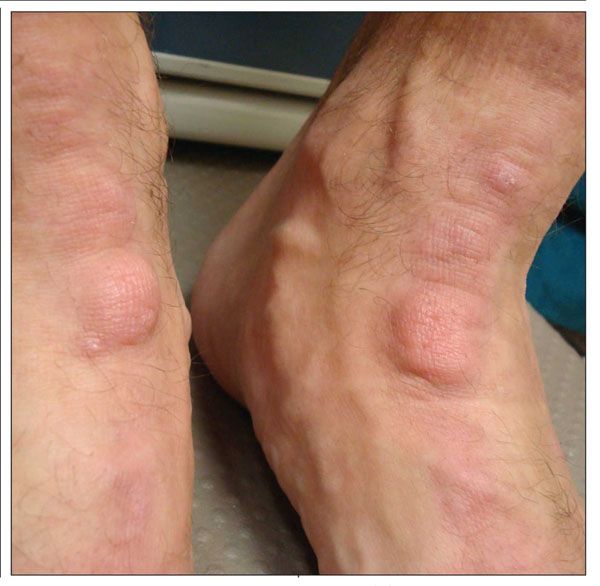- Clinical Technology
- Adult Immunization
- Hepatology
- Pediatric Immunization
- Screening
- Psychiatry
- Allergy
- Women's Health
- Cardiology
- Pediatrics
- Dermatology
- Endocrinology
- Pain Management
- Gastroenterology
- Infectious Disease
- Obesity Medicine
- Rheumatology
- Nephrology
- Neurology
- Pulmonology
Collagenomas
During a skin cancer screening, a 45-year-old male soldier was noted to have bilateral subcutaneous nodules on the dorsa of his feet. The patient reported that the nodules had remained unchanged since they first appeared in his early 20s and were asymptomatic. He had no other lesions.

During a skin cancer screening, a 45-year-old male soldier was noted to have bilateral subcutaneous nodules on the dorsa of his feet. The patient reported that the nodules had remained unchanged since they first appeared in his early 20s and were asymptomatic. He had no other lesions.
The nodules were about 3 cm, well-circumscribed, skin-colored, slightly firm, and freely mobile. Overlying the nodules and adjacent skin were faint erythematous linear bands, which corresponded to areas of pressure and friction produced by the patient’s combat boots.
Repetitive friction or rubbing of the skin can result in local irritation that leads to a connective-tissue reaction. This can cause an increased number of collagen fibers and a thickening of the dermis, known as collagenomas, or athlete’s nodules.1 These lesions often occur on the feet of runners, football players, and surfers and on the hands of boxers and marble players. The exact prevalence is unknown.2
In this patient, the collagenomas may have been precipitated by extensive marching early in his military career, as suggested by the presence of the nodules in areas of friction caused by his combat boots. Although the patient’s father also had similar long-standing lesions on the ankles, familial cutaneous collagenoma (FCC) was considered unlikely. This disease is typically characterized by multiple symmetrically distributed nodules on the trunk and upper extremities that are not caused by friction.3 FCC is also associated with heart disease, which this patient did not have.
Unfortunately, the term “athlete’s nodules” has been used to describe a wide range of nodules that are different from collagenomas, both clinically and histologically. Nodules that resolve spontaneously after discontinuation of the irritating activity are more likely to be pseudobursae; these have been reported in runners and ice-skaters as “Nike nodules” and “skate bites,” respectively.4 A true collagenoma is generally a long-standing nodule that does not spontaneously resolve.
Treatment is usually unnecessary for asymptomatic collagenomas but may include intralesional corticosteroids or local excision.1
Disclosures:
The views expressed here are those of the authors and do not reflect the official policy or position of the Department of the Army, Department of Defense, or the US Government.
References:
REFERENCES:1. Cohen PR, Eliezri YD, Silvers DN. Athlete’s nodules: sports-related connective tissue nevi of the collagen type (collagenomas). Cutis. 1992;50:131-135.
2. Athlete’s nodules. In: Adams BB, ed. Sports Dermatology. New York: Springer; 2006:95.
3. Phillips JC, Knautz MA, Sangueza OP, Davis LS. Familial cutaneous collagenoma. J Am Acad Dermatol. 1999;40:255-257.
4. Pharis DB, Teller C, Wolf JE Jr. Cutaneous manifestations of sports participation. J Am Acad Dermatol. 1997;36(3, pt 1):448-459.
The views expressed here are those of the authors and do not reflect the official policy or position of the Department of the Army, Department of Defense, or the US Government.
